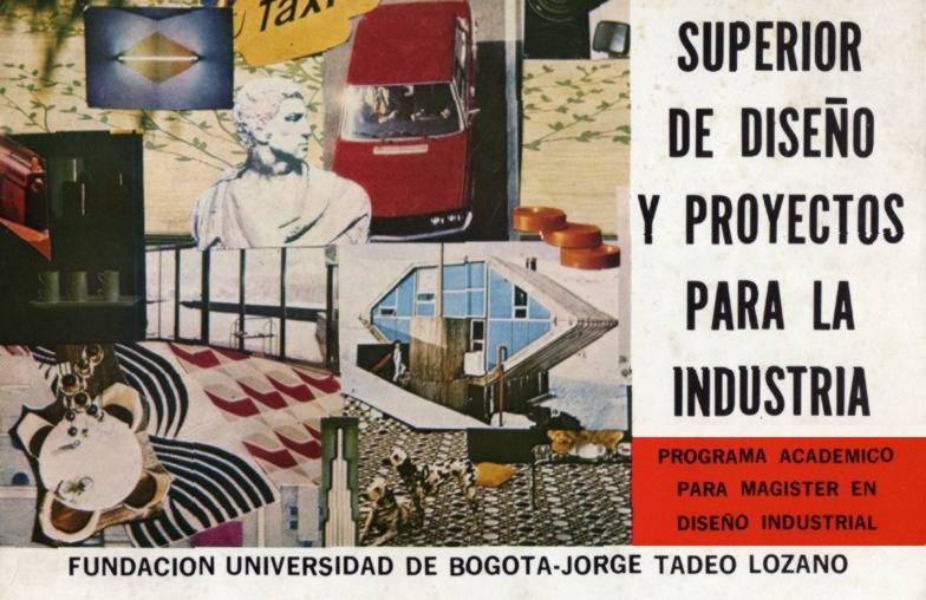The Roots of Industrial Design Colleges in Colombia
Looking back from two theories about its origin.

The development of industrial design education in Colombia has been underway for half a century. Yet, two different theories have emerged about its origins. The most traditional of these is published by Silvia Fernandez, and directs attention to the European heritage of the practice. The latter is espoused by Juan Camilo Buitrago, and focuses on cultural autonomy. To understand this topic through the lenses of these two historians, it is important to explain a bit about the context in which design education developed.
A Country Under Construction
In the mid 50’s, the future of Colombia was full of uncertainty. On the political side there was a transition going from a Military Council to democracy as an agreement between political leaders Lleras Camargo and Laureano Gomez. This agreement was intended to stop the violence generated by the different ideas of the followers of the two political groups.
On the production side there was a new industry based on machines using new materials and aesthetic trends. The products of these new industrial processes began to compete with those made by traditional artisan groups.
In addition to the production side, the technological side contributed with two events that moved the country into the Modernity Era. One was the inauguration of television by General Rojas Pinilla and second, the introduction of the first mega-computer IBM 650 by the Bavaria Beer Company. Besides in the cultural aspects, the country was driven by ideas that were imported by Colombians who had received an education abroad.

Regarding the education component, traces of industrial design started in the late 50’s at the University of the Andes and at National University in Bogota. The architect Alvaro Ortega who had studied abroad taught the first workshop in basic design.
The first singular industrial design course took place in 1966 and featured elements of the Bauhaus School from Germany. In 1967 a complete graphic design program was founded at the Jorge Tadeo Lozano University, it was guided by Anna de Jacobini and David Consuegra. But it was not until 1973 that the first complete industrial design program appeared at the Pontificia Bolivariana University of Medellin.
In that same year, the first Masters of industrial design program was founded by the Institute of Design and Industry Projects of the Jorge Tadeo Lozano University. This Master program was directed toward architects, civil engineers and people who work in the industry.

The Two Theories Published
Inside the design community there are several theories about the origins of Industrial Design. But only two of these have been substantively documented and these are written by Silvia Fernandez and Juan Camilo Buitrago.
First Theory
Silvia Fernandez wrote her views about the beginnings of design in Colombia in a chapter of the text «The Origins of Design Education in Latin America: From the hfg (Hochschule für Gestaltung) in Ulm to Globalization».
In the text she illuminates the theory that Latin American countries like Colombia have a European heritage specifically from Ulm, the German school of design. One reason is that Ingo Werk and Gerd Schussler, graduates from the German School, left a legacy as teachers in certain South American universities. A second reason is that early Latin American design schools were influenced by Ulm academic thinking, especially with an emphasis on semiology (How the form of a product intuitively communicates to the user how to interact with that product. This also describes the process by which users assign meaning to a product).
Fernandez goes on to describe the German institution as follows:
«The HFG had shown itself as an institution of strong character, free, self-critical, intransigent on programmatic questions, with a transparent educational strategy which more than once has pushed beyond the limits, clear in the area of project definition, immune to soft compromises, with strong convictions and objectives which went beyond simple academic formation and demanded of its participants social commitment and a critical attitude towards reality.»
This prevaling theory was traditionally accepted by most of the design community in Colombia. And parts of the information in the section about Colombia was based on a graphic time line originally published by the team of Proyectodiseño magazine in 2002 (cf. Gutierrez, 2012:30).
Second Theory
Juan Camilo Buitrago, in his document «Social creativity: the professionalization of industrial design in Colombia» (2012), brings a different perspective.
He notes that in Colombia industrial design was derived from traditional design processes that might be considered a «liberal discipline» or a non mainstream disciplines for that time. Foundations of these traditional processes as metalworking, carpentry and joinery became professional’s inputs for the discipline.
Buitragoʼs awareness recognized the progression of a fundamental twentieth century social transformation that paralleled the industrial revolution of Colombia. And questioned the idea of Silvia Fernandez, from a lineal connection to the Germany school into an idea of an autonomy culture that circulated at the National University in the sixties.
A new career in Colombia
Just as in 1936, when some engineers supported the creation of an architecture program at National University, the late 60’s produced a similar effect powered by a generation of architects. These architectural professionals, considered dissidents in their field, migrate to industrial design and participated in the founding of the industrial design in Colombia. The having come from Bogota’s middle class, most of these men had earlier been architecture students at National University between 1954 and 1974.

Finally, industrial design practice is rich with visual and physical imagines from hand sketches to working prototypes. Even, including programing of projects descriptions and solutions. But the historical written has never been a part of our strengths, therefore, in order to maintain cultural and historical continuity, it is imperative that more design students and professionals investigate and document the evolving history of our profession.
What do you think? Share your comments right now!
Help to spread this article by translating it
Translate to spanish Translate to italian Translate to portugueseBibliografía:
- MARTINEZ GORROÑO, María Eugenia (2004) «La educación en la Colombia liberal de los años 30 y 40: la transcendente contribución del exilio español consecuencia de la Guerra Civil 1936-1939» en Migraciones y Exilios: Cuadernos de la Asociación para el estudio de los exilios y migraciones ibéricos contemporáneos. Vol 4 pp. 9-30. [Education in Colombia liberal of the 30 and 40: the transcendent contribution from exile following the Spanish Civil War 1936-1939].
- FERNANDEZ, Silvia (2006). «The Origins of Design Education in Latin America: From the hfg in Ulm to Globalization», en Design Issues 22, no. 1 (January 1); pp. 3-19.
- GUTIERREZ, Alfredo (2012) Las situaciones diseñadas, Tesis de Maestria, Escuela de estudios de género, Facultad de Ciencias Humanas, Universidad Nacional de Colombia, Bogota, version digital en http://www.bdigital.unal.edu.co/9013/1/489178.2012.pdf recuperado en 12/06/2013. [Designed situations, Masterʼs Thesis, School of Gender Studies, Faculty of Humanities, National University of Colombia, Bogota, digital version].
- BUITRAGO, Juan Camilo (2012) Creatividad social: La profesionalización del diseño industrial en Colombia, Univalle. [Social creativity: The professionalization of industrial design in Colombia].
- GUTIERREZ, Alfredo; ANGULO, Camilo (2013) «Cuatro decadas del diseño industrial tadeista», Documento interno, junio, PDI – UJTL. [Four decades of industrial design at The Tadeo" Internal Document, Jorge Tadeo Lozano University].
- H. ALPAY Er & LANGRIS John (1993) «Industrial design in developing countries: a review of the literature», en IAS Research Papers, RP-66, Institute of Advanced Studies, Manchester Metropolitan University.
- PDI [PROGRAMA DE DISEÑO INDUSTRIAL] UJTL (2008). PEP, Proyecto Educativo del Programa de diseño industrial de la Universidad Jorge Tadeo Lozano. [PEP, Program Educational Project industrial design at the University Jorge Tadeo Lozano].
- PROYECTODISEÑO (pd), (2002) «Historia del diseño de producto en Colombia» Siglo XX Bogotá, Colombia. [History product design in Colombia» Twentieth Century Bogotá, Colombia].
- PULGAR VIDAL, Javier (2004) «Apuntes para la historia de la Tadeo» pp. 31-36 en Revista LA TADEO 50 AÑOS, Edición No. 69, sobre texto originalmente publicado en Revista La Tadeo No. 23, 1989. [Notes on the history of Tadeo» pp. 31-36 in LATADEO 50 YEARS Magazine, Issue No. 69, on text originally published in The Journal Tadeo No. 23, 1989].
- HOOPER, Percy (2013). Product Development and Entrepreneurship Initiative. NC State University.
- PEREZ, Jaime. (2001) . La Colombia de hace 50 años [Colombia 50 years ago].
- Semiotics in Wikipedia.

This article does not express the opinion of the editors and managers of FOROALFA, who assume no responsibility for its authorship and nature. To republish, except as specifically indicated, please request permission to author. Given the gratuity of this site and the hyper textual condition of the Web, we will be grateful if you avoid reproducing this article on other websites. Published on 06/02/2014


























